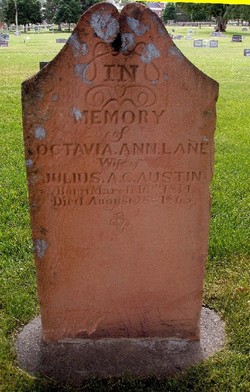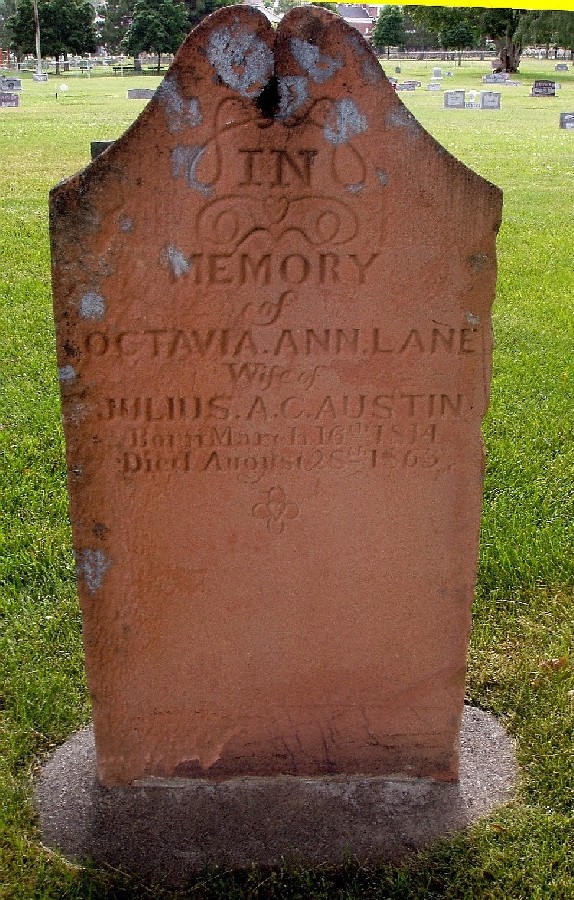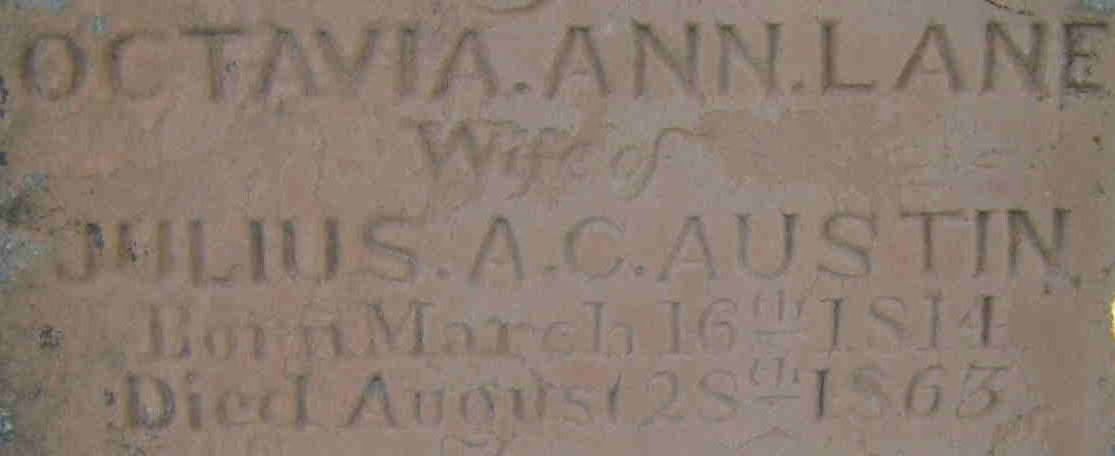Siblings - Norman Lane, Alane Lane, Caroline Elizabeth Lane, Newton Lane, Emeline Amanda Lane
Married Julius Augustus Caesar Austin, 26 Sep 1835, Suffield, Hartford, Connecticut
Children - Louise Maria Austin, Edwin Nelson Austin, Newton Francis Austin, Julia Ann Austin
Our Pioneer Heritage, Vol. 3, p. 514
Octavia Ann was born March 16, 1814 at Suffield, Hartford county Connecticut, the second child and eldest daughter of Ashbel and Ann Stannard Lane. On September 15, 1835 she married Julius Augustus Caesar Austin, a young man living in Suffield. He was a carpenter and joiner by trade and previous to their marriage had built a comfortable home. In time four children were born to them, namely, Louise Maria, born 21 June 1838; Edwin Nelson born 5 September, 1840; Newton Francis born July, 1843, and Julia Ann born and died May 1, 1845.
The Austins come in contact with Mormon Elders Ezra T. Benson and John M. Woolley and shortly thereafter accepted the gospel. They were baptized in the Connecticut river after the ice had been broken so that the ordinance could be performed, on January 10, 1844. Persecution of the Saints for their beliefs was beginning to become intolerable and when the decision was made for the Eastern Saints to accompany Elder Samuel Brannan to the west coast, the Austins sold their home, furniture and nearly all their possessions to get the money needed for passage for the parents, their three children, and also Emmaline Lane, the youngest sister of Octavia.
When the ship arrived at Honolulu Octavia wrote the following letter to her people in Connecticut:
"We have come 20,000 miles and are nearing our destined home, I trust. We crossed the equator 28 days after we sailed from New York. We had a very good passage around Cape Horn. The days were very short; we could hardly get a glimpse of the sun for several days but we got around first rate. We arrived at this port on the 22nd day of June and our ship is lying at the wharf. The natives received us kindly. There were hundreds of them it seemed, waiting to see us land and we have been treated well by all classes during our sojourn here. All the Americans were glad to see us and invited us to come and see them. When we arrived an American Man-of-War was here which will go ahead to protect us. A number of whale ships are in port. While the Natives of the Islands are very kind and friendly, they are very indolent and it is the greatest place for gossip I ever saw. We have created a great deal of excitement among them but they think well of us, I believe.
"The white missionaries treat us very well, but I do not think they would care to have us stay very long. Brother Brannan has preached once for them. I went to the native church last Sunday and heard one of the missionaries preach in the native tongue. He said a great deal about us as I afterwards learned, but I could not understand him. I don't think the missionaries have done much good here; they degrade the natives. Here the white ladies are drawn around in two-wheeled vehicles by the natives. I saw a great many of them drawn to church by them and men too. I think it would have looked better had they gone on foot. Many of the natives wear scarcely any clothing at all. They are rather dark complexioned but not black. They have straight hair, black eyes and are very large in size, very fleshy people."
After docking in Yerba Buena Cove, the Austin family was one of the sixteen families who made a temporary home in the Mexican barracks. Part of the building was then occupied by Mexicans who were kind to the family and often gave them food. Mr. Austin, being a carpenter, obtained employment on buildings then being erected and this provided means for the family, for they, like other Brooklyn Saints, were without money when they arrived in California.
Early in 1848 quite a number of the Brooklyn Saints and also some members of the Mormon Battalion left San Francisco for the gold diggings, among them the Austin family. They were there only a short time when word came from President Brigham Young that Great Salt Lake Valley had been designated as the gathering place for the Saints. As soon as enough gold had been panned to buy outfits, wagons, horses, cattle and general supplies for the overland journey to Salt Lake, they again resumed their pilgrimage, this time by what was then known as the northern route. Edwin said: "We left the gold fields of California for the Gospel but we've had no regrets, for the Gospel is worth more than all the gold of the Indies. When ready to start a company was organized by electing Ebenezer Brown, a second sergeant of Co. A., Mormon Battalion, as captain of the company. After leaving the mines the company journeyed north to 'Hang Town,' thence over and through the Sierras, down the Truckee river through Nevada (then a country without habitation); thence up the Mary's river (now Humboldt) through Thousand Spring Valley, across the Goose Creek and the City of Rocks (in Cassia county, Idaho) around the north end of the Great Salt Lake, crossing Malad and Bear rivers near the northern boundaries of the now state of Utah, down the east side of the lake over the country where Brigham City now stands (then a desert waste); thence south along the foot hills, crossing Ogden river where we found a few log cabins thrown together in the brush to house some mountaineers and pioneers for the winter. From there we crossed the Weber river and on to Salt Lake Valley where we arrived October, 1848, at the old Pioneer Fort.
"Here we were kindly received by the pioneers who came overland from the East, and housed for the winter. As soon as we were located we again started up a school for the winter of 1848–49, and John Eager, Brooklyn Mormon taught the school. Some moved out onto city lots in the spring and planted gardens and commenced to build homes. Although we were neutrals in those days we were forced into the cricket and locust wars, the former in 1849, and the latter little pests nearly devastated the country. Had it not been for our allies, the gulls, we would surely have starved. Even with the help of the birds we were reduced to at least a meager diet. It was sure enough wheatless and meatless days with us."
In 1849 or 1850 the Austin family moved to North Cottonwood Ward where they lived until after 1852. On the 8th of March, Octavia and Julius went to the old Endowment House and were endowed and sealed for time and eternity. Sometime after this the family moved to Farmington, Utah where they were pioneers in that fast growing community and where Octavia enjoyed the association of her many friends. She was a true and faithful Latter-day Saint, firm in her convictions to the last.
Octavia Ann Austin died suddenly at her home in Farmington, 27 August, 1863 at the age of 49 years. She was buried in the Farmington cemetery. Julius died March 3, 1903 in Laketown, Rich, Utah.
Siblings - Norman Lane, Alane Lane, Caroline Elizabeth Lane, Newton Lane, Emeline Amanda Lane
Married Julius Augustus Caesar Austin, 26 Sep 1835, Suffield, Hartford, Connecticut
Children - Louise Maria Austin, Edwin Nelson Austin, Newton Francis Austin, Julia Ann Austin
Our Pioneer Heritage, Vol. 3, p. 514
Octavia Ann was born March 16, 1814 at Suffield, Hartford county Connecticut, the second child and eldest daughter of Ashbel and Ann Stannard Lane. On September 15, 1835 she married Julius Augustus Caesar Austin, a young man living in Suffield. He was a carpenter and joiner by trade and previous to their marriage had built a comfortable home. In time four children were born to them, namely, Louise Maria, born 21 June 1838; Edwin Nelson born 5 September, 1840; Newton Francis born July, 1843, and Julia Ann born and died May 1, 1845.
The Austins come in contact with Mormon Elders Ezra T. Benson and John M. Woolley and shortly thereafter accepted the gospel. They were baptized in the Connecticut river after the ice had been broken so that the ordinance could be performed, on January 10, 1844. Persecution of the Saints for their beliefs was beginning to become intolerable and when the decision was made for the Eastern Saints to accompany Elder Samuel Brannan to the west coast, the Austins sold their home, furniture and nearly all their possessions to get the money needed for passage for the parents, their three children, and also Emmaline Lane, the youngest sister of Octavia.
When the ship arrived at Honolulu Octavia wrote the following letter to her people in Connecticut:
"We have come 20,000 miles and are nearing our destined home, I trust. We crossed the equator 28 days after we sailed from New York. We had a very good passage around Cape Horn. The days were very short; we could hardly get a glimpse of the sun for several days but we got around first rate. We arrived at this port on the 22nd day of June and our ship is lying at the wharf. The natives received us kindly. There were hundreds of them it seemed, waiting to see us land and we have been treated well by all classes during our sojourn here. All the Americans were glad to see us and invited us to come and see them. When we arrived an American Man-of-War was here which will go ahead to protect us. A number of whale ships are in port. While the Natives of the Islands are very kind and friendly, they are very indolent and it is the greatest place for gossip I ever saw. We have created a great deal of excitement among them but they think well of us, I believe.
"The white missionaries treat us very well, but I do not think they would care to have us stay very long. Brother Brannan has preached once for them. I went to the native church last Sunday and heard one of the missionaries preach in the native tongue. He said a great deal about us as I afterwards learned, but I could not understand him. I don't think the missionaries have done much good here; they degrade the natives. Here the white ladies are drawn around in two-wheeled vehicles by the natives. I saw a great many of them drawn to church by them and men too. I think it would have looked better had they gone on foot. Many of the natives wear scarcely any clothing at all. They are rather dark complexioned but not black. They have straight hair, black eyes and are very large in size, very fleshy people."
After docking in Yerba Buena Cove, the Austin family was one of the sixteen families who made a temporary home in the Mexican barracks. Part of the building was then occupied by Mexicans who were kind to the family and often gave them food. Mr. Austin, being a carpenter, obtained employment on buildings then being erected and this provided means for the family, for they, like other Brooklyn Saints, were without money when they arrived in California.
Early in 1848 quite a number of the Brooklyn Saints and also some members of the Mormon Battalion left San Francisco for the gold diggings, among them the Austin family. They were there only a short time when word came from President Brigham Young that Great Salt Lake Valley had been designated as the gathering place for the Saints. As soon as enough gold had been panned to buy outfits, wagons, horses, cattle and general supplies for the overland journey to Salt Lake, they again resumed their pilgrimage, this time by what was then known as the northern route. Edwin said: "We left the gold fields of California for the Gospel but we've had no regrets, for the Gospel is worth more than all the gold of the Indies. When ready to start a company was organized by electing Ebenezer Brown, a second sergeant of Co. A., Mormon Battalion, as captain of the company. After leaving the mines the company journeyed north to 'Hang Town,' thence over and through the Sierras, down the Truckee river through Nevada (then a country without habitation); thence up the Mary's river (now Humboldt) through Thousand Spring Valley, across the Goose Creek and the City of Rocks (in Cassia county, Idaho) around the north end of the Great Salt Lake, crossing Malad and Bear rivers near the northern boundaries of the now state of Utah, down the east side of the lake over the country where Brigham City now stands (then a desert waste); thence south along the foot hills, crossing Ogden river where we found a few log cabins thrown together in the brush to house some mountaineers and pioneers for the winter. From there we crossed the Weber river and on to Salt Lake Valley where we arrived October, 1848, at the old Pioneer Fort.
"Here we were kindly received by the pioneers who came overland from the East, and housed for the winter. As soon as we were located we again started up a school for the winter of 1848–49, and John Eager, Brooklyn Mormon taught the school. Some moved out onto city lots in the spring and planted gardens and commenced to build homes. Although we were neutrals in those days we were forced into the cricket and locust wars, the former in 1849, and the latter little pests nearly devastated the country. Had it not been for our allies, the gulls, we would surely have starved. Even with the help of the birds we were reduced to at least a meager diet. It was sure enough wheatless and meatless days with us."
In 1849 or 1850 the Austin family moved to North Cottonwood Ward where they lived until after 1852. On the 8th of March, Octavia and Julius went to the old Endowment House and were endowed and sealed for time and eternity. Sometime after this the family moved to Farmington, Utah where they were pioneers in that fast growing community and where Octavia enjoyed the association of her many friends. She was a true and faithful Latter-day Saint, firm in her convictions to the last.
Octavia Ann Austin died suddenly at her home in Farmington, 27 August, 1863 at the age of 49 years. She was buried in the Farmington cemetery. Julius died March 3, 1903 in Laketown, Rich, Utah.
Family Members
Advertisement
Advertisement













